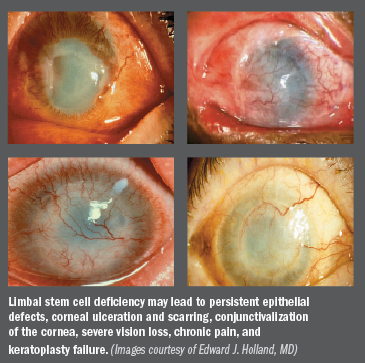Article
Dealing with limbal stem cell deficiency
There are many causes of limbal stem cell deficiency and it is important to know how to recognize them and how to intervene.
Take-Home
There are many causes of limbal stem cell deficiency and it is important to know how to recognize them and how to intervene.

Dr. Holland
By Fred Gebhart; Reviewed by Edward Holland, MD
Cincinnati, OH- limbal stem cell deficiency is a growing problem that is often not recognized and not treated in the early stages, said Edward Holland, MD.
When recognized and treated early, the loss of limbal epithelial stem cells can usually be halted or reversed, but if allowed to progress to total limbal deficiency, there are few viable treatment options short of surgery, he said.
“Ophthalmologists typically understand acute causes of limbal stem cell deficiency, like chemical or thermal trauma, and some of the congenital causes, such as congenital aniridia,” said Dr. Holland, director, cornea service, Cincinnati Eye Institute and professor of ophthalmology, Cincinnati University. “But we are also seeing an increased incidence of limbal stem cell deficiency (LSCD) in patients with chronic ocular surface disease and in patients who have had mitomycin for pterygium and glaucoma surgery. The most notable increase in LSCD is coming in patients who have worn long term contact lenses.”
One of the biggest surprises to many clinicians, he said, is the incidence of LSCD associated with common restorative and curative procedures, such as contact lenses and ocular surgery for cataracts and glaucoma.
“There are many more common causes of LSCD than ophthalmologists and optometrists realize,” Dr. Holland said. “If not recognized and treated, LSCD progresses to total limbal deficiency. At that point, we have a challenging surgical management to undertake.”
Complications
LSCD may lead to persistent epithelial defects, corneal ulceration and scarring, conjunctivalization of the cornea, severe vision loss, chronic pain, and keratoplasty failure.
This cascade of events is often initiated by acute insult to the eye, such as alkali or acid injury, multiple ocular surface surgeries, thermal injury, or radiation.
Inflammatory eye diseases-such as Sjögren’s syndrome, vernal keratoconjunctivitis, mucous membrane pemphigoid, and others-are widely recognized to affect limbal stem cells.
Any number of bacterial, viral and parasitic pathogens can affect limbal function and regeneration.
But it is the slow and chronic insults, such as contact lens use, dry eye, or toxicity from topical medications that can be difficult, even counterintuitive, to diagnose, Dr. Holland said.
“The noncorneal specialist needs to recognize that there are numerous causes of limbal deficiency besides some of the devastating injuries and diseases that we all know about,” he said. “If you recognize a patient with progressive severe ocular surface disease and you eliminate that surface inflammation, you can probably stop the development of limbal deficiency.”
The single most important intervention in the contact lens-wearing patient is closer attention to the limbus and peripheral epithelium, Dr. Holland said. Any sign of chronic peripheral epithelial abnormality in a contact lens wearer is reason to suspect limbal insufficiency.
“I don’t want to imply that contact lenses are bad,” he said. “LSCD is a rare complication. There are over 30 million contact lens wearers in the United States and the vast majority are doing great. But limbal complications should be part of your differential every time you are working up an abnormal epithelium in a contact lens wearer.”

Combating the problem
Convincing patients to stop wearing contacts can be tough, Dr. Holland said, as most contact wearers like the visual improvement that contacts bring. But in patients with early limbal deficiency, wearing contacts relieves ocular discomfort even as it contributes to inflammation and limbal damage.
“You have to explain the potentially devastating problem they could have with contact lenses and limbal deficiency,” he said. “If the contacts are stopped, the patient will do fine. But if the patient continues to wear contacts over the next few years, the rest of the limbus can become affected and progress to permanent limbal deficiency.”
The growing use of mitomycin in ocular surgery is another contributing factor to the increasing prevalence of limbal stem cell deficiency.
Patients who undergo a single procedure that involves mitomycin may be at relatively low risk if the surgeon takes appropriate steps to protect the limbus.
However, patients who undergo multiple surgeries with mitomycin or use the agent to manage ocular surface squamous neoplasia are at much higher risk for limbal involvement.
“Early recognition of limbal involvement means you have an opportunity to arrest progression,” Dr. Holland said. “Once you get to the severe stage, treatment is much more difficult. We typically start with supportive care to reduce inflammation, most often topical steroids or cyclosporine.
“Sometime agents such as autologous serum are helpful,” he continued. “In some patients, a temporary soft bandage contact lens is helpful or maybe a scleral contact lens. But once you have progressed to total limbal deficiency with total corneal involvement, you have to consider surgical management.”
Edward Holland, MD
E: eholland@holprovision.com
Dr. Holland reported no financial conflicts of interest.
Subscribe to Ophthalmology Times to receive the latest clinical news and updates for ophthalmologists.
Newsletter
Don’t miss out—get Ophthalmology Times updates on the latest clinical advancements and expert interviews, straight to your inbox.





